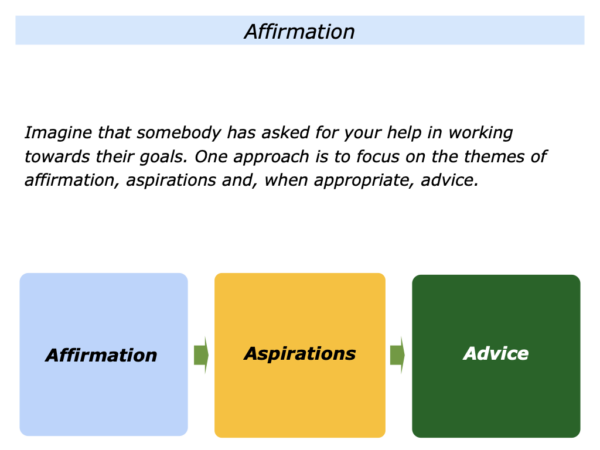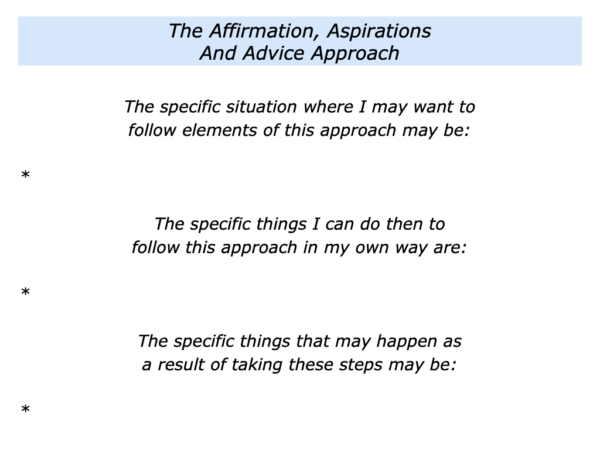
Imagine that a person has asked for your help in working towards their goals. This could be in a personal or professional situation. One approach is to focus on the following themes.
Affirmation
This involves focusing on: a) the positive parts of the person; b) the positive things they have done in the past. It is important to be positive but realistic when focusing on these things.
Aspirations
This involves focusing on: a) the positive things the person wants to do in the future; b) the positive things they would like people to be saying about what they do.
Advice
This part should only be done if appropriate and if the person asks for ideas. It involves passing on knowledge that the person can use to achieve their goals.
It is important to be careful when sharing ideas. These should be based on what works rather than just giving your opinions. The person can then use these in their own way to work towards achieving their goals.
Imagine that you want to follow elements of this approach when helping a person to achieve their aims. This involves focusing on the following themes.
Affirmation
People are more likely to grow when they get encouragement and affirmation. Such affirmation must be based on reality, however, rather than just saying they are good.
Sometimes the affirmation comes from themselves. A person may feel they have been true themselves, done what they believe in and also achieved their aims.
Sometimes affirmation comes from outside. A person may be given encouragement, do good work and get positive feedback. This can help to lift a person’s soul.
There may be many situations, however, where this feedback is not forthcoming. This does not necessarily mean the person has not done good work. It may simply mean that other people are not in the habit of giving positive feedback.
Let’s return to the person who has asked for your help in working to achieve their goals. One approach is to simply to move straight on to clarifying their aspirations.
Another approach is to invite the person to describe the specific topics they want to explore. If appropriate, however, you may want to say something along the following lines.
“We will soon focus on how to achieve your aims. Before then, however, it would be good to know about your strengths. We can then look at how to build on these to achieve your goals. Would that be okay?”
Imagine that the person says this is okay. It can then be useful to explore the following themes. You can do this by asking them questions or, if appropriate, giving your own ideas about when they show these qualities.
As mentioned earlier, it is important to be realistic when taking this approach. At the same time, encouraging a person to talk about these things can be affirming and strengthen their ability to shape the future. Here are the topics it can be useful to explore.
The Positive Things
About The Person
What are the positive things about the person? When do they demonstrate a positive attitude? How do they translate this into action? What may sometimes happen as a result of them taking those steps?
When does the person encourage other people? When do they show warmth? How do they translate this encouragement into action? What may sometimes happen as a result of taking these steps?
What gives the person positive energy? When do they come alive? When are they in their element – at ease and yet able to excel? When do they go into a state of flow?
What are the person’s strengths? What are the specific activities in which they may deliver As rather than Bs or Cs? What are the things they feel passionately about where they may be able to deliver peak performances?
When does the person have a sense of purpose? What are the principles they may want to follow in their life? How do they sometimes translate these principles into practice?
The Positive Things The
Person Has Done In The Past
What are some of the positive things they have done in the personal life? What have done to encourage and help other people? What were the situations in which they did these things?
What are some of the positive things they have done in their professional life? What were the situations where they did these things? What were the specific things they achieved?
What is their successful style of working? What have been one or two projects they found satisfying? What did they do right then? What were the principles they followed? How did they translate these into action?
Imagine that you have explored some of these topics with the person. Different people may react in different ways but the normal reaction is positive.
The person can feel energised by revisiting the times when they have helped others or achieved success. This can provide a platform for focusing on the next step towards helping them to achieve their goals.
Aspirations
Everybody has aspirations. They may have challenges they want to solve or goals they want to achieve. It is often possible to provide help that they can use to work towards their picture of success.
Imagine that the person you are working with is prepared to put in the effort required to reach their goals. If appropriate, you can take the following approach.
You can clarify the topics they
want to explore and the
goals they want to achieve
Different people will obviously want to explore different topics. Here are some of the many themes that individuals may mention.
How to regain control of my life … How to do satisfying work … How to help my son who is having difficulties at school … How to stay calm in certain situations … How to build a positive culture in an organisation.
Imagine that the person has described the goals they want to achieve. You can then move on to the next stage.
You can focus on the first topic and
clarify the real results they want
to achieve – the picture of success
You can focus on the first topic they want to explore. Clarity is vital. Bearing in mind what they can control in the situation, it is important to clarify the real results they want to achieve.
A leader may say, for example, that they want to understand how to motivate a talented but difficult team member. The real results they want to achieve, however, are to build a positive and successful team.
Imagine that a person has said they want to achieve a particular goal. If appropriate, you may want to clarify their aims by exploring the following questions with them.
What is their specific goal? What are the real results they want to achieve? What is the picture of success? What will be the benefits of achieving the goal?
What will be happening that will show they have achieved the goal? What will be the things that they and, if appropriate, other people will be feeling, saying or doing?
What may be the pluses and minuses involved in working towards achieving the goal? Bearing this in mind, on a scale 0-10 how motivated is the person to do what is required to achieve the goal?
Imagine that you have explored this step. Before moving forwards, it can be useful to check you are clear on what the person wants to achieve. You may want to say something along the following lines.
“As far as I understand, the real results you want to achieve in this situation are:
“To …
“To …
“To …
“Is that right?”
Imagine that both of you are clear on the results to achieve. If appropriate, it can then be time to move on to the next stage.
Advice
The person has asked for your help in working to achieve their goals. Bearing this in mind, it can be useful to go through the following stages when taking this steps.
You can help the person to explore
the possible options going forwards
This can be a useful first step. If appropriate, you can say something along the following lines.
“Looking ahead, there are several options for working towards achieving the goals. Some of these build on your strengths and some offer other ways forwards.
“Let’s start by considering these possible options. Each route has both pluses and minuses. Here are some of the options. You may also want to add some other possible ways forward.”

Imagine that both of you have brainstormed the various possibilities. If appropriate, you can then move on to the next step.
You can share knowledge that the
person can use to achieve their goals
This is where advisors can earn their corn. They pass on their knowledge in a way the person can use to in their own way. Imagine that you are going to take this route. Before sharing ideas you can ask yourself the following questions.
What are the results the person wants to achieve? What are the key strategies they can follow to give themselves the greatest chance of success?
What are the kinds of knowledge, models and practical tools that I can share to help them to achieve their goals? How can I pass on this knowledge in a way they can accept and use?
Imagine that you want to pass on such knowledge. Before doing so, however, it can be important to ask the person:
“Is it okay for me to share some ideas?”
Let’s assume the person would welcome your ideas. You may say something along the following lines.
“Looking at the goals you want to achieve, here are some options you may wish to consider.
“One possibility is …
“Another possibility is …
“Another possibility is …”
You will share your knowledge in your own way. When doing so it can be useful to look for the ideas that resonate with the person. You can then follow up these in greater depth.
Imagine that you have taken this step. At a certain point you may then move on to the next stage.
You can help the person to work towards
achieving their picture of success
Let’s assume you have focused on the first theme the person wanted to explore. You will have clarified the real results to achieve and the possible options going forwards.
Imagine the person is ready to move into action. If appropriate, you can then explore the following steps. You can help the person:
To settle on the option – or combination of options – they want to follow towards achieving their aims;
To rehearse following their chosen option, move into action and get some early successes;
To keep building on what is working, keep tackling areas for improvement and do their best to achieve their picture of success.
The person can follow these steps on the first theme they wanted to explore. If appropriate, you can encourage them repeat the process when helping them to work towards their other goals.
There are many ways to help people. One approach is to go through the stages of affirmation, aspirations and, when appropriate, providing advice in a way they can accept and use.
Let’s return to your own life and work. Looking ahead, can you think of a situation where you may want to follow elements of this approach? How can you do this in your own way?
If you wish, try tackling the exercise on this theme. This invites you to complete the following sentences.







Leave a Reply